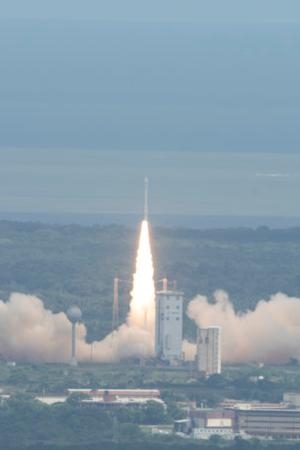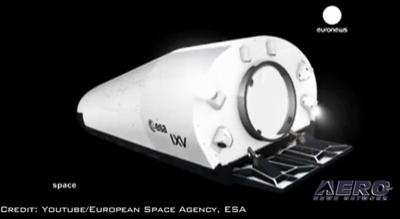Initial Data Release Expected In About Six Weeks
An experimental vehicle to develop an autonomous European reentry capability for future reusable space transportation has completed its mission. ESA’s Intermediate eXperimental Vehicle flew a flawless reentry and splashed down in the Pacific Ocean just west of the Galapagos islands.

The IXV spaceplane lifted off at 1340 GMT on 11 February from Europe’s Spaceport in Kourou, French Guiana atop a Vega rocket. It separated from Vega at an altitude of 211 miles and continued up to 256 miles. Reentering from this suborbital path, it recorded a vast amount of data from more than 300 advanced and conventional sensors.
As it descended, the five-metre-long, two-tonne craft manoeuvred to decelerate from hypersonic to supersonic speed. The entry speed of 4.6 miles/second at an altitude of 74 miles created the same conditions as those for a vehicle returning from low Earth orbit.
IXV glided through the atmosphere before parachutes deployed to slow the descent further for a safe splashdown in the Pacific Ocean.
The Mission Control Center at the ALTEC Advanced Logistics Technology Engineering Centre in Turin, Italy, closely monitored IXV during the mission, receiving flight and instrument data from the entire ground network, including the fixed ground stations in Libreville (Gabon) and Malindi (Kenya), and the station on the Nos Aries recovery ship in the Pacific.
IXV will be returned to Europe for detailed analysis in ESA’s technical center, ESTEC, in the Netherlands.
Mastering reentry will open a new chapter for ESA. Such a capability is a cornerstone for reusable launcher stages, sample return from other planets and crew return from space, as well as for future Earth observation, microgravity research, satellite servicing and disposal missions.
The initial results from the flight are expected to be released in around six weeks.
The results will feed the Program for Reusable In-Orbit Demonstrator for Europe, or Pride, which is being studied under funding decided at ESA’s last two Ministerial Councils. The reusable Pride spaceplane would be launched on Europe’s Vega light rocket, orbit and land automatically on a runway.
“IXV has opened a new chapter for ESA in terms of reentry capabilities and reusability,” explains Jean-Jacques Dordain, ESA Director General.
“ESA and its Member States, together with European space industry, are now ready to take up new challenges in several fields of space transportation, in future launchers, robotic exploration or human spaceflight.”

“This mission will teach us a lot about the technologies we need to apply in new launch systems, in particular when we think about reusable systems,” said Gaele Winters, ESA Director of Launchers.
“This was a short mission with big impact,” added Giorgio Tumino, IXV project manager. “The cutting-edge technology we validated today, and the data gathered from the sensors aboard IXV, will open numerous opportunities for Europe to develop ambitious plans in space transportation for a multitude of applications.”
(Image provided by ESA)
 ANN's Daily Aero-Term (04.28.24): Airport Marking Aids
ANN's Daily Aero-Term (04.28.24): Airport Marking Aids Aero-News: Quote of the Day (04.28.24)
Aero-News: Quote of the Day (04.28.24) ANN's Daily Aero-Linx (04.28.24)
ANN's Daily Aero-Linx (04.28.24) Aero-News: Quote of the Day (04.29.24)
Aero-News: Quote of the Day (04.29.24) ANN's Daily Aero-Linx (04.29.24)
ANN's Daily Aero-Linx (04.29.24)




